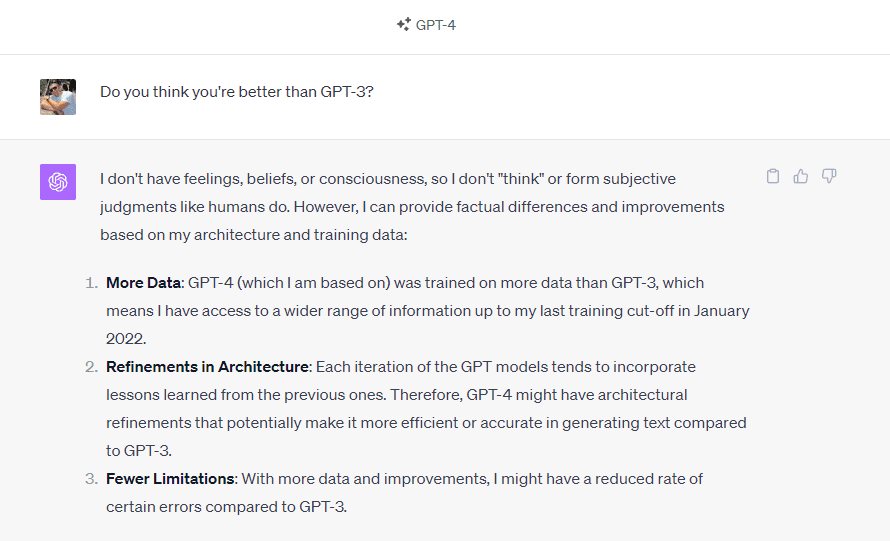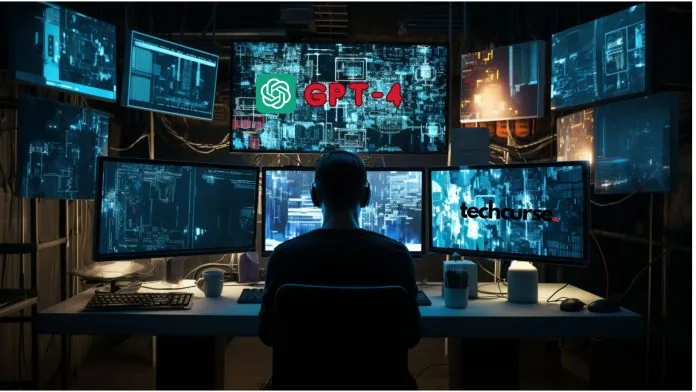GPT-4, the latest OpenAI language model, comes with exciting features and capabilities. It’s a deep-learning model trained for natural language processing and text generation. This advanced version offers improved performance over GPT-3, showcasing its evolution in AI-based technology.
For those in a hurry, let’s highlight the most essential aspects of GPT-4. After that, we’ll take a more detailed look into the GPT-4 model.
- GPT-4 is a super advanced AI model that can convert image inputs into text and mimics human-like speech almost perfectly.
- Using it costs money, with the ChatGPT Plus subscription costing $20 monthly. The GPT-4 API has a different cost.
- It’s better than GPT-3 in many ways because it has more features and better language understanding.
- It has more memory than GPT-3, allowing the model to remember and give more detailed responses.
- Even though it’s very powerful, it still has some limitations, like inconsistent results and potential biases.
What is GPT-4?

GPT-4, or Generative Pretrained Transformer 4, represents the latest evolution in artificial intelligence systems. It’s an enormous multimodal model that accepts both image and text inputs to produce human-like text outputs.
The system operates like a seasoned mimic, replicating human speech and reasoning with impressive fidelity. GPT-4’s training hinges on extensive online data, allowing it to generate intricate responses far surpassing its predecessors, such as GPT-3.
Developed by OpenAI, this technologically advanced tool embodies cutting-edge progress within the field of AI.
Key features and capabilities
GPT-4 marks a significant milestone in the development of language processing. It boasts powerful new features and enhanced functionalities. Among its expanded capabilities, its ability to convert image inputs into text is an impressive leap forward for artificial intelligence models.
As OpenAI’s latest AI language model, GPT-4 also includes multimodal processing, pushing the frontier on how we interact with technology and making it more versatile and dynamic.
Despite these advancements, it shares similar constraints with earlier models and isn’t completely reliable yet – something that warrants due attention as we navigate this exciting innovation landscape.
Training model
GPT-4 employs an innovative training model, utilizing a massive dataset to refine its language processing capabilities. This process combines both unsupervised generative pre-training and supervised fine-tuning techniques, effectively learning language patterns and predicting text.
OpenAI has improved this version by building on previous GPT models while incorporating undisclosed upgrades for optimized performance. This semi-supervised training methodology used in GPT-4 ensures the advanced evolution of generative pretraining techniques essential for developing upcoming artificial intelligence advancements.
With these upgraded features incorporated into GPT-4, we expect continuous improvements in future iterations of this groundbreaking language model.
GPT-4 vs GPT-3
When it comes to comparing GPT-4 and GPT-3, there are several key distinctions to consider. While both are impressive language models, GPT-4 advances in several significant ways, enhancing the capabilities and pushing the boundaries of AI language development.
| Factor | GPT-3 | GPT-4 |
|---|---|---|
| Parameters | Considerably smaller than GPT-4. | Boasts a staggering 100 trillion parameters, substantially larger than GPT-3. |
| Fact-based Data | Produces less fact-based data. | Produces 40% more fact-based data than GPT-3. |
| Dialect Understanding | Less understanding and generating different dialects of human-like text. | Greater ability to understand and generate different dialects of human-like text. |
| Mode of Operation | Processes only text. | A multimodal system, it can process both images and text. |
Data from these models is based on their training from terabytes of internet content. The capabilities of GPT-4 are a testament to the growing complexity and potential of artificial intelligence models. However, even with these advancements, it’s important to remember that GPT-4, like GPT-3, is still less capable than humans in many real-world tasks.
How you can access GPT-4

Gaining access to GPT-4 involves a few straightforward steps.
- Visit the official website of OpenAI, chat.openai.com.
- Create an account for free (you can use GPT-3)
- To use GPT-4, you need a ChatGPT Plus account for $20 per month.
- GPT-4 API is not included in the ChatGPT Plus subscription (more below).
- Enjoy the capabilities of GPT-4!
Costs associated with using GPT-4
Choosing to use GPT-4 carries with it some significant financial considerations. The ChatGPT Plus subscription comes with a monthly price tag of $20. If you prefer the text-only API, it starts at $0.03 per 1k prompt, making it more costly than its predecessor, GPT-3.5.
It’s important to understand that training costs also skyrocketed for this model – they soared up to around $63 million due to high computational power demands and extensive time investment required for training processes.
Furthermore, using the GPT-4 API brings an even higher expense than the GPT-3 API due to its advanced capabilities and computational needs.
Improvements and Limitations
GPT-4, like any other AI model, isn’t immune to limitations and potential biases.
Performance improvements compared to previous versions
GPT-4 sets new standards in the language model universe with its advanced proficiency and fine-tuned performances. It surpasses GPT-3.5, significantly enhancing understanding of context and differentiating nuances, leading to more accurate and coherent responses.
Its capabilities extend beyond simple tasks as it now handles complex challenges with an improved level of truthfulness and reduced offensive content output. This leap forward doesn’t come without effort; OpenAI invested countless hours honing these improvements to ensure that GPT-4 exhibits human-level performance across numerous professional and academic tasks, unlike previous versions.

Limitations
Despite GPT-4’s commendable performance, it is not immune to flaws. We might encounter inconsistencies in results or biases built into the model. The AI chatbot exhibits an impressive leap over its predecessor, ChatGPT, but some lingering issues still exist.
It sometimes falls prey to social biases, delivers hallucinated responses, and can be susceptible to adversarial prompts. Furthermore, even though GPT-4 offers more politically neutral content than previous models, offensive or harmful information is slipping through the cracks, which could compromise reliability for businesses relying on it heavily. It also “hallucinates” in certain cases or contexts, especially if it’s a more complex issue or it doesn’t have all the data.
GPT-4 Implications
Discover how GPT-4 is reshaping industries with its advanced applications and anticipate future trends it might spark. Dive in deeper to explore this fascinating world.
Applications in various industries
GPT-4 profoundly impacts various industries due to its advanced features and capabilities.
- GPT-4 revolutionizes how businesses interact with customers in the customer service industry. Its multimodal interface delivers swift responses, providing high-quality customer experiences.
- The marketing sector utilizes GPT-4 to generate creative content, from blog posts to catchy ad copies. This AI-driven approach streamlines content creation processes, saving crucial time and resources.
- In the software development industry, GPT-4 changes how people develop apps. It provides accurate coding suggestions, making code-writing quicker and more efficient. It’s also very proficient in writing code.
- Researchers benefit from GPT-4’s zero-shot learning capabilities, as it aids in digging out useful information from massive datasets quickly.
- Educational institutions can harness GPT-4’s abilities to aid in personalized learning and collaborative education systems.
- With model alignment improvements, companies worry less about offensive content generation and can focus more on utilizing AI for positive impacts.
Future trends and developments
We expect GPT-4 to continue leading natural language processing advancements. With each new version, there’s a significant improvement over the previous models, and we can only anticipate that trend with GPT-4.
Future developments will likely see deeper user-uploaded image integration into its learning process. As a large multimodal model accepting image and text inputs and generating text outputs, this has tremendous potential for enhancing its capabilities and features.
Even as we marvel at these advancements, we must keep an eye on the limitations compared to human capabilities.
Final Word
GPT-4 stands as a remarkable advancement in artificial intelligence. This deep learning model, with its capacity to process both image and text inputs, has altered the landscape of language processing.
It continues to amaze us with its human-like speech generation and reasoning abilities, opening new horizons in numerous industries.





